Characteristics of Strong Cold Air Outbreaks in China’s Central and Eastern Mongolian Region between 1970 and 2013
Abstract
:1. Introduction
2. Data and Methods
2.1. Data
2.2. Definition of Strong CAOs
2.3. Tracing and Calculation of Tracks
3. Results
3.1. Track Differences
3.2. Origin Difference
3.3. General Circulation of Atmosphere
3.4. Impacts of Strong CAOs on Downstream Areas
3.5. Heat Budget Analysis of Downstream Areas
4. Conclusions and Discussion
- (1)
- The strong CAOs of different tracks intruding central and eastern Inner Mongolia in the winter-half years of 1970–2013 can be classified based on track differences into four types: 303 incidents of northwest tracks intruding from the north side of the Altai Mountains; 118 incidents of north tracks intruding from along the Yablonoi Mountains; 32 incidents of west tracks generally intruding from the south side of the Altai Mountains; and 16 incidents of “unusual” tracks.
- (2)
- The circulation evolution before outbreaks causes a temperature increase of 9.71 °C for cold air masses of northwest tracks, 6.42 °C of west tracks, and 10.40 °C of north tracks, which altogether denote a weakening of influences for origin differences in the potential temperatures of cold air masses.
- (3)
- West tracks are mainly impacted by the warm high anomaly of Eastern Europe and the negative phase changes at AO (which causes continuous cold advection transport in polar regions). Both of these factors are thought to likely influence the existence of the abnormally low temperatures in Northwest China with notable temperature decreases in the southeast regions of the country (south of 35° N) over a period of three consecutive days. North tracks are largely influenced by the warm high anomaly of the Ural Mountains, which may cause sharp temperature decreases in East China resulting in a greater possibility of cold-related damage. Northwest tracks are typically engendered by cold air masses at high latitudes that move southward in tandem with the East Asian winter monsoon circulation. The Siberian high under northwest tracks is weaker than these under the west and north tracks, and northwest tracks mainly impacting Northeast China.
Acknowledgments
Author Contributions
Conflicts of Interest
References
- Hsu, H.H.; Wallace, J.M. Vertical structure of wintertime teleconnection patterns. J. Atmos. Sci. 1985, 42, 1693–1710. [Google Scholar] [CrossRef]
- Lau, K.M.; Chang, C.P. Planetary scale aspects of the winter monsoon and atmospheric teleconnections. Monsoon. Meteorol. 1987, 7, 161. [Google Scholar]
- Yang, S.; Lau, K.M.; Kim, K.M. Variations of the East Asian jet stream and Asian–Pacific–American winter climate anomalies. J. Clim. 2002, 15, 306–325. [Google Scholar] [CrossRef]
- Chen, W.; Graf, H.F.; Huang, R.H. The interannual variability of East Asian winter monsoon and its relation to the summer monsoon. Adv. Atmos. Sci. 2000, 17, 48–60. [Google Scholar]
- Park, T.W.; Ho, C.H.; Yang, S. Relationship between the Arctic Oscillation and Cold Surges over East Asia. J. Clim. 2011, 24, 68–83. [Google Scholar] [CrossRef]
- Boyle, J.S.; Chen, T.J. Synoptic aspects of the wintertime East Asian monsoon. In Monsoon Meteorology; Chang, C.P., Krishnamurti, T.N., Eds.; Oxford University Press: Oxford, UK, 1987; pp. 125–160. [Google Scholar]
- Ding, Y.H.; Meng, X. A case study of development of a cold surge after outbreak of cold wave in East Asia. Acta Meteorol. Sin. 1994, 52, 442–451. (In Chinese) [Google Scholar]
- Chen, T.C. A North Pacific Short-Wave Train during the Extreme Phases of ENSO. J. Clim. 2001, 15, 2359–2376. [Google Scholar] [CrossRef]
- Moschos, N.; Christoforaki, M.; Antonatos, P. Seasonal distribution of acute myocardial infarction and its relation to acute infections in a mild climate. Int. J. Card. 2004, 93, 39–44. [Google Scholar] [CrossRef]
- Wang, Z.Y.; Ding, Y.H. Climate Change of the Cold Wave Frequency of China in the Last 53 Years and the Possible Reasons. Chin. J. Atmos. Sci. 2006, 30, 1068–1076. (In Chinese) [Google Scholar]
- Qian, W.H.; Zhang, W.W. Changes in Cold Wave Events and Warm Winter in China during the Last 46 Years. Chin. J. Atmos. Sci. 2007, 31, 1266–1278. (In Chinese) [Google Scholar]
- Wang, Z.M.; Sun, Z.B.; Li, Z.X.; Hong, N.D. Variation characteristics of strong cold air activity frequency in eurasia from 1949 to 2009. Meteorol. Disast. Reduct. Res. 2011, 34, 16–23. (In Chinese) [Google Scholar]
- Gong, D.Y.; Wang, S.W. Influence of Arctic Oscillation on winter climate over China. J. Geogr. Sci. 2003, 13, 208–216. [Google Scholar]
- Zhang, Y.; Sperber, K.R.; Boyle, J.S. Climatology and interannual variation of the East Asian winter monsoon: Results from the 1979–95 NCEP/NCAR reanalysis. Mon. Weather Rev. 1997, 125, 2605–2619. [Google Scholar] [CrossRef]
- Zhang, Y.; Wang, W.C. Model-simulated northern winter cyclone and anticyclone activity under a greenhouse warming scenario. J. Clim. 1997, 10, 1616–1634. [Google Scholar] [CrossRef]
- Gong, D.Y.; Ho, C.H. The Siberian High and climate change over middle to high latitude Asia. Theor. Appl. Climatol. 2002, 72, 1–9. [Google Scholar] [CrossRef]
- Gong, D.Y.; Ho, C.H. Intra-seasonal variability of wintertime temperature over East Asia. Int. J. Climatol. 2004, 24, 131–144. [Google Scholar] [CrossRef]
- Takaya, K.; Nakamura, H. Mechanisms of Intraseasonal Amplification of the Cold Siberian High. J. Atmos. Sci. 2005, 62, 4423–4440. [Google Scholar] [CrossRef]
- Takaya, K.; Nakamura, H. Geographical Dependence of Upper-Level Blocking Formation Associated with Intraseasonal Amplification of the Siberian High. J. Atmos. Sci. 2004, 62, 4441–4449. [Google Scholar] [CrossRef]
- Ding, Y.; Krishnamurti, T.N. Heat budget of the Siberian high and the winter monsoon. Mon. Weather Rev. 1987, 115, 2428–2449. [Google Scholar] [CrossRef]
- Yihui, D. Build-up, air mass transformation and propagation of Siberian high and its relations to cold surge in East Asia. Meteorol. Atmos. Phys. 1990, 44, 281–292. [Google Scholar] [CrossRef]
- Joung, C.H.; Hitchman, M.H. On the role of successive downstream development in East Asian polar air outbreaks. Mon. Weather Rev. 1982, 110, 1224–1237. [Google Scholar] [CrossRef]
- Lau, N.C.; Lau, K.M. The structure and energetics of midlatitude disturbances accompanying cold-air outbreaks over East Asia. Mon. Weather Rev. 1984, 112, 1309–1327. [Google Scholar] [CrossRef]
- Park, T.W.; Jeong, J.H.; Ho, C.H.; Kim, S.J. Characteristics of atmospheric circulation associated with cold surge occurrences in East Asia: A case study during 2005/06 winter. Adv. Atmos. Sci. 2008, 25, 791–804. [Google Scholar] [CrossRef]
- Shi, N.; Bueh, C. Three-dimensional dynamic features of two arctic oscillation types. Adv. Atmos. Sci. 2013, 30, 1039–1052. [Google Scholar] [CrossRef]
- Bueh, C.; Li, Y.; Lin, D.W.; Lian, Y. Interannual variability of summer rainfall over the northern part of China and the related circulation features. J. Meteorol. Res. 2016, 30, 615–630. [Google Scholar] [CrossRef]
- Li, F.; Jiao, M.Y.; Ding, Y.H.; Jin, R.H. Climate change of arctic atmospheric circulation in last 30 years and its effect on strong cold events in China. Plateau Meteor. 2006, 25, 209–219. [Google Scholar]
- Xie, A.; Lu, Y.; Chen, S.J. The Evolution of Siberian High Prior to the Outbreak of Cold Air (in Chinese). Chin. J. Atmos. Sci. 1992, 16, 677–685. [Google Scholar]
- Walsh, J.E.; Phillips, A.S.; Portis, D.H.; Chapman, W.L. Extreme cold outbreaks in the United States and Europe, 1948–99. J. Clim. 2001, 14, 2642–2658. [Google Scholar] [CrossRef]
- Kalnay, E.; Kanamitsu, M.; Kistler, R.; Collins, W.; Deaven, D.; Gandin, L.; Iredell, M.; Saha, S.; White, G.; Woollen, J. The NCEP/NCAR 40-year reanalysis project. Bull. Am. Meteorol. Soc. 1996, 77, 437–471. [Google Scholar] [CrossRef]
- Climate Prediction Center (CPC). Teleconnections: Arctic Oscillation. Available online: http://www.cpc.ncep.noaa.gov/products/precip/CWlink/daily_ao_index/ao.shtml (accessed on 1 October 2016).
- Draxler, R.R. Boundary layer isentropic and kinematic trajectories during the August 1993 North Atlantic Regional Experiment Intensive. J. Geophys. Res. Atmos. 1996, 101, 29255–29268. [Google Scholar] [CrossRef]
- Stohl, A. Computation, accuracy and applications of trajectories—A review and bibliography. Atmos. Environ. 1998, 32, 947–966. [Google Scholar] [CrossRef]
- Lee, J.G.; Han, J.W.; Whang, K.Y. Trajectory Clustering: A Partition-and-Group Framework. In Proceedings of the 2007 ACM SIGMOD International Conference on Management of Data, Beijing, China, 11–14 June 2007; Association for Computing Machinery: New York, NY, USA, 2007; pp. 593–604. [Google Scholar]
- Jhun, J.G.; Lee, E.J. A new East Asian winter monsoon index and associated characteristics of the winter monsoon. J. Clim. 2004, 17, 711–726. [Google Scholar] [CrossRef]
- Holton, J.R.; Hakim, G.J. An Introduction to Dynamic Meteorology, 5th ed.; Academic Press: London, UK, 2012; pp. 146–147. [Google Scholar]
- Konrad, C.E.; Colucci, S.J. An examination of extreme cold air outbreaks over eastern North America. Mon. Weather Rev. 1989, 117, 2687–2700. [Google Scholar] [CrossRef]
- Wang, H.; Gong, Q.; Sun, F.; Yang, S. Temperature anomaly features in northeast China and east of North China and primarily analysis of its mechanism. Plateau Meteorol. 2005, 24, 1024–1033. [Google Scholar]
- Portis, D.H.; Cellitti, M.P.; Chapman, W.L.; Walsh, J.E. Low-frequency variability and evolution of North American cold air outbreaks. Mon. Weather Rev. 2006, 134, 579–597. [Google Scholar] [CrossRef]
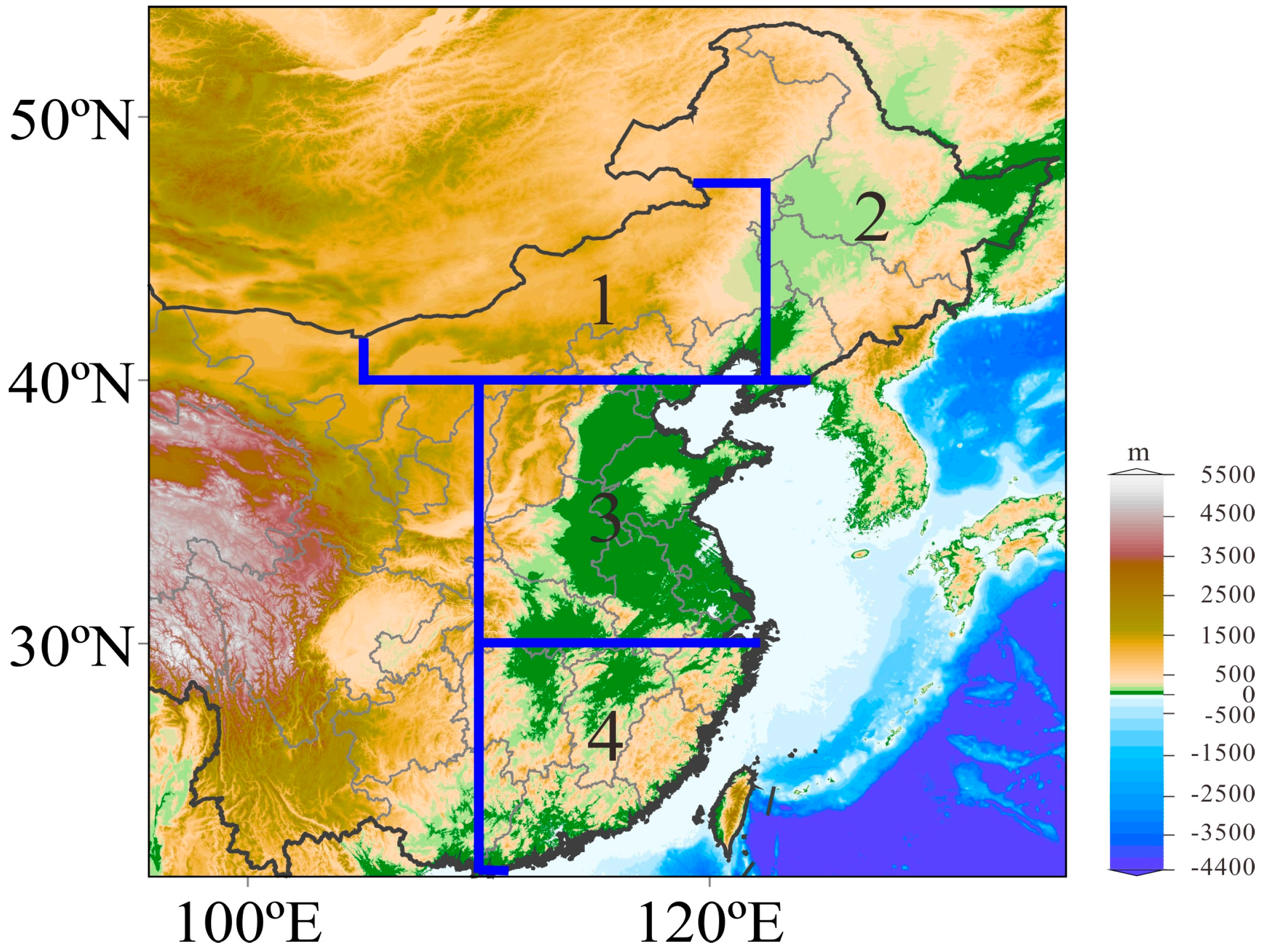
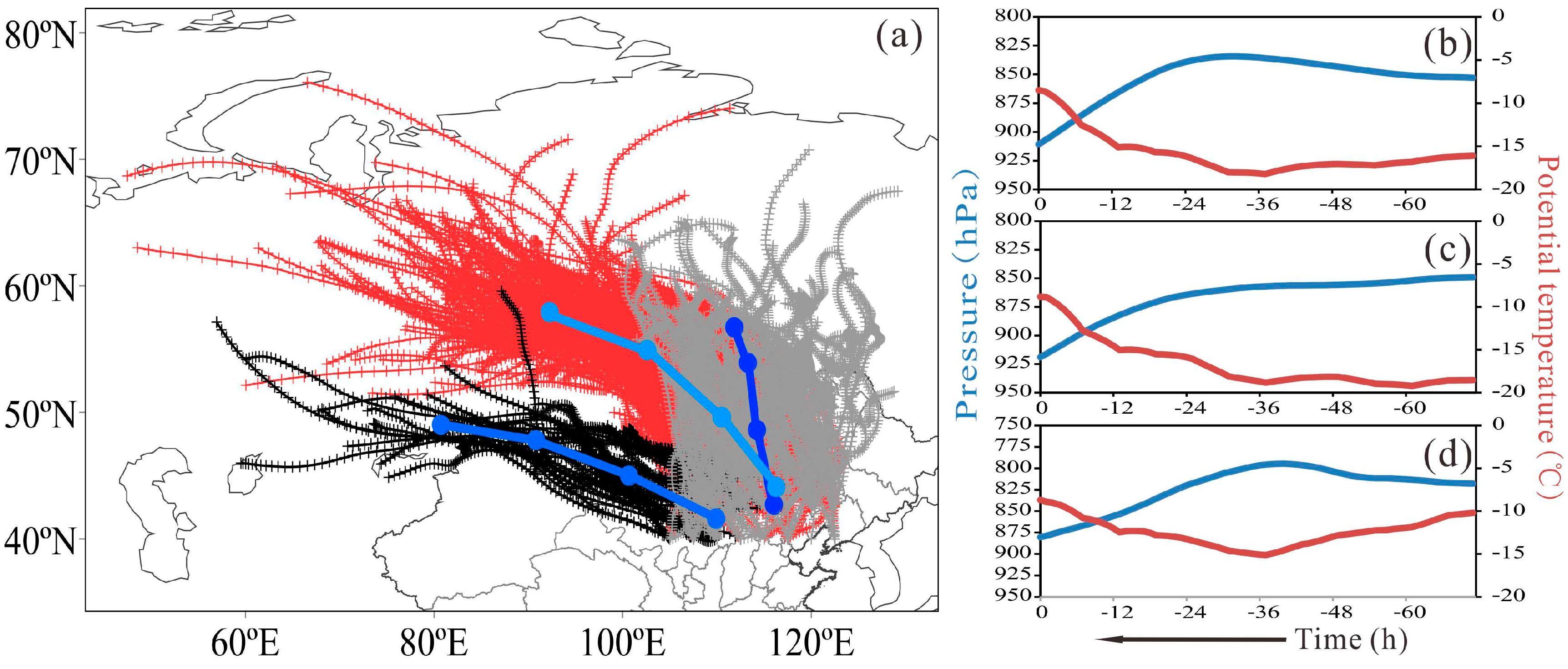
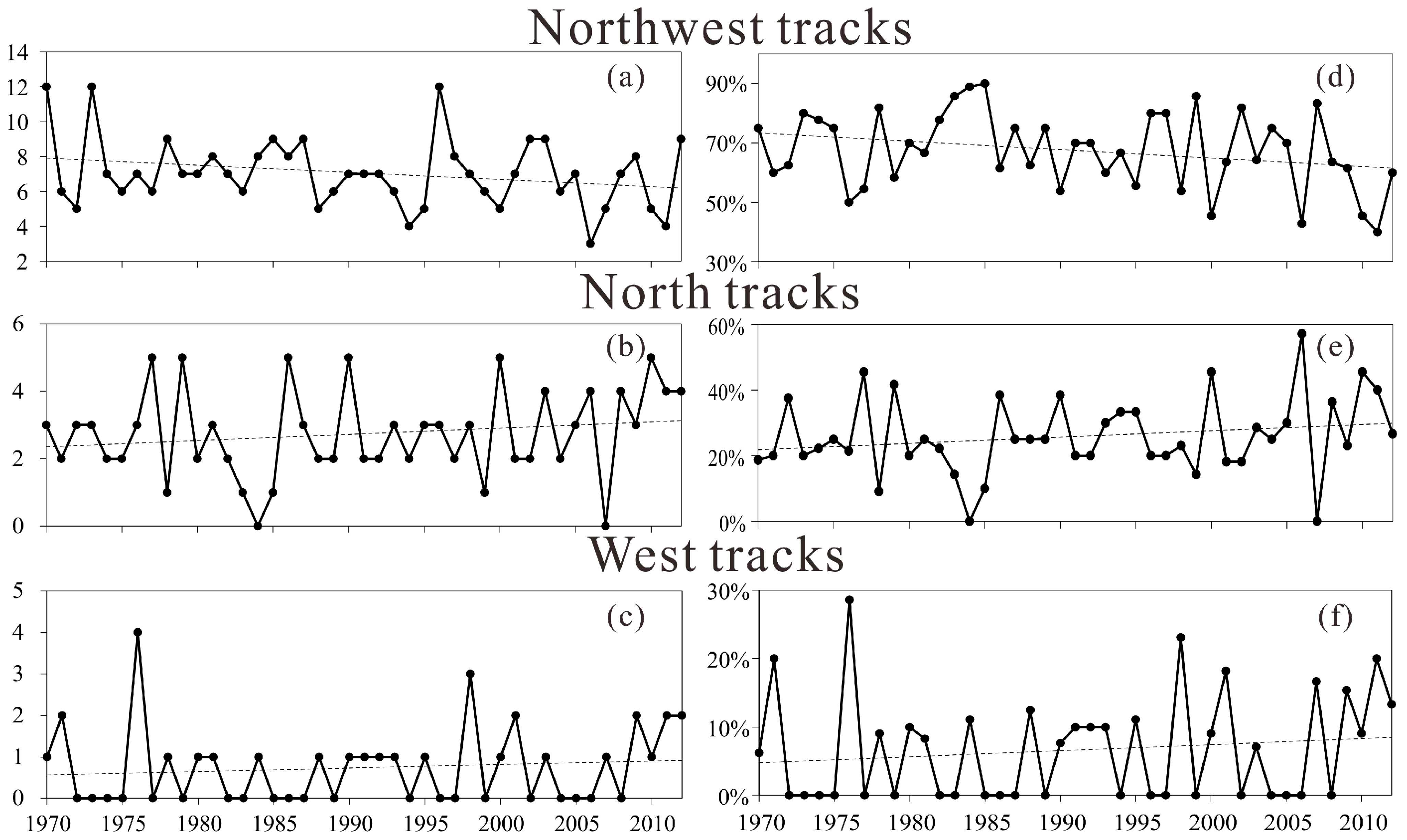

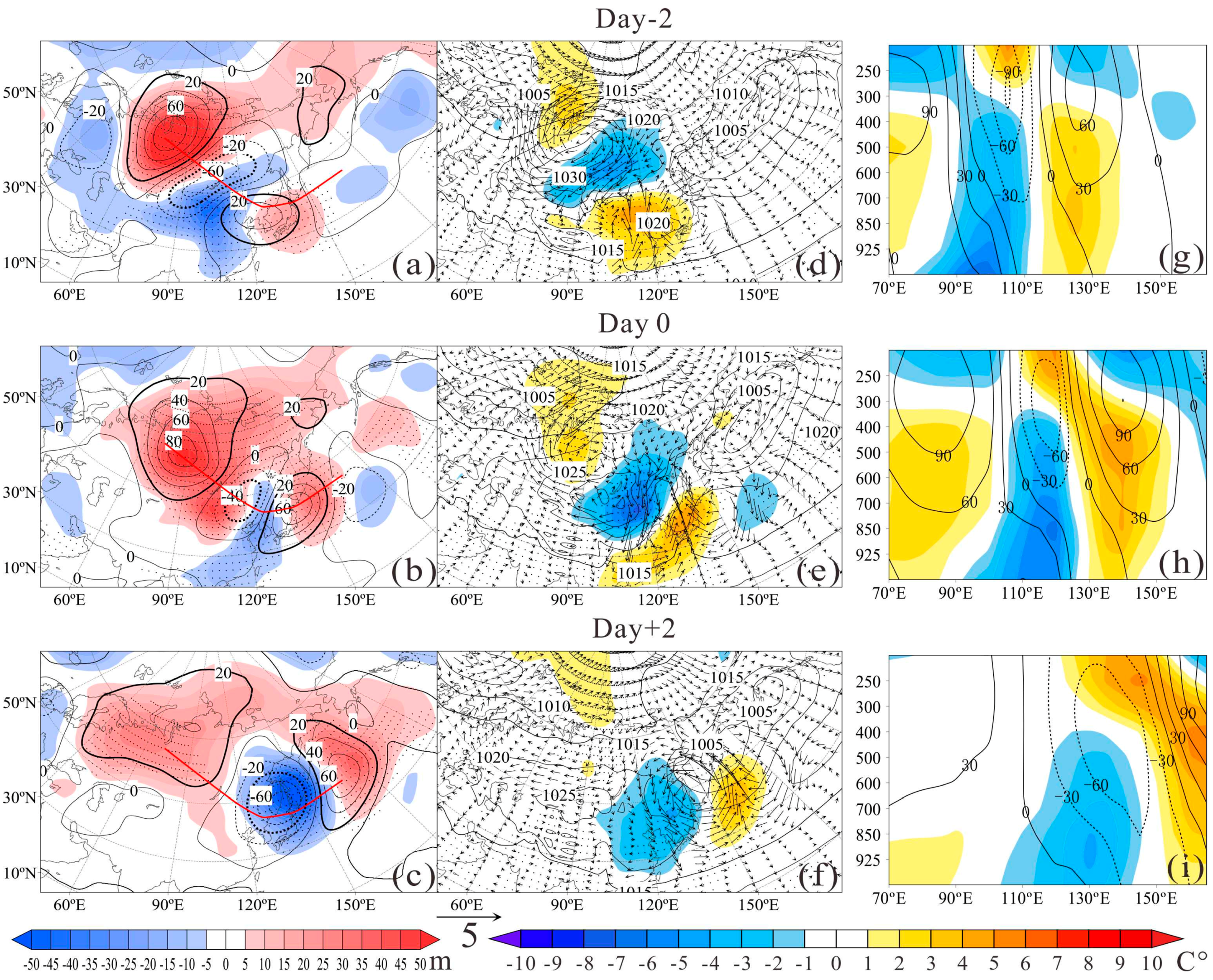
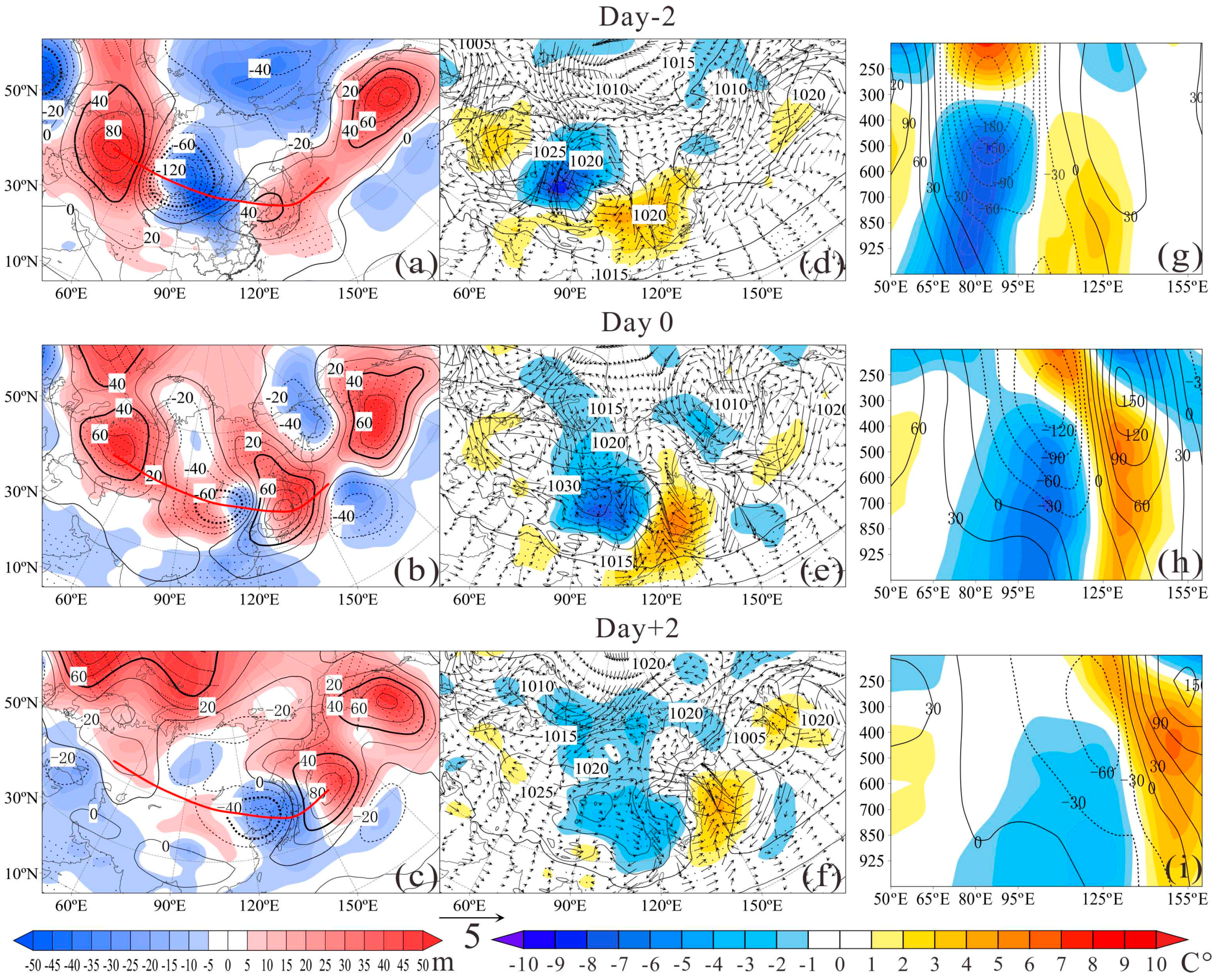

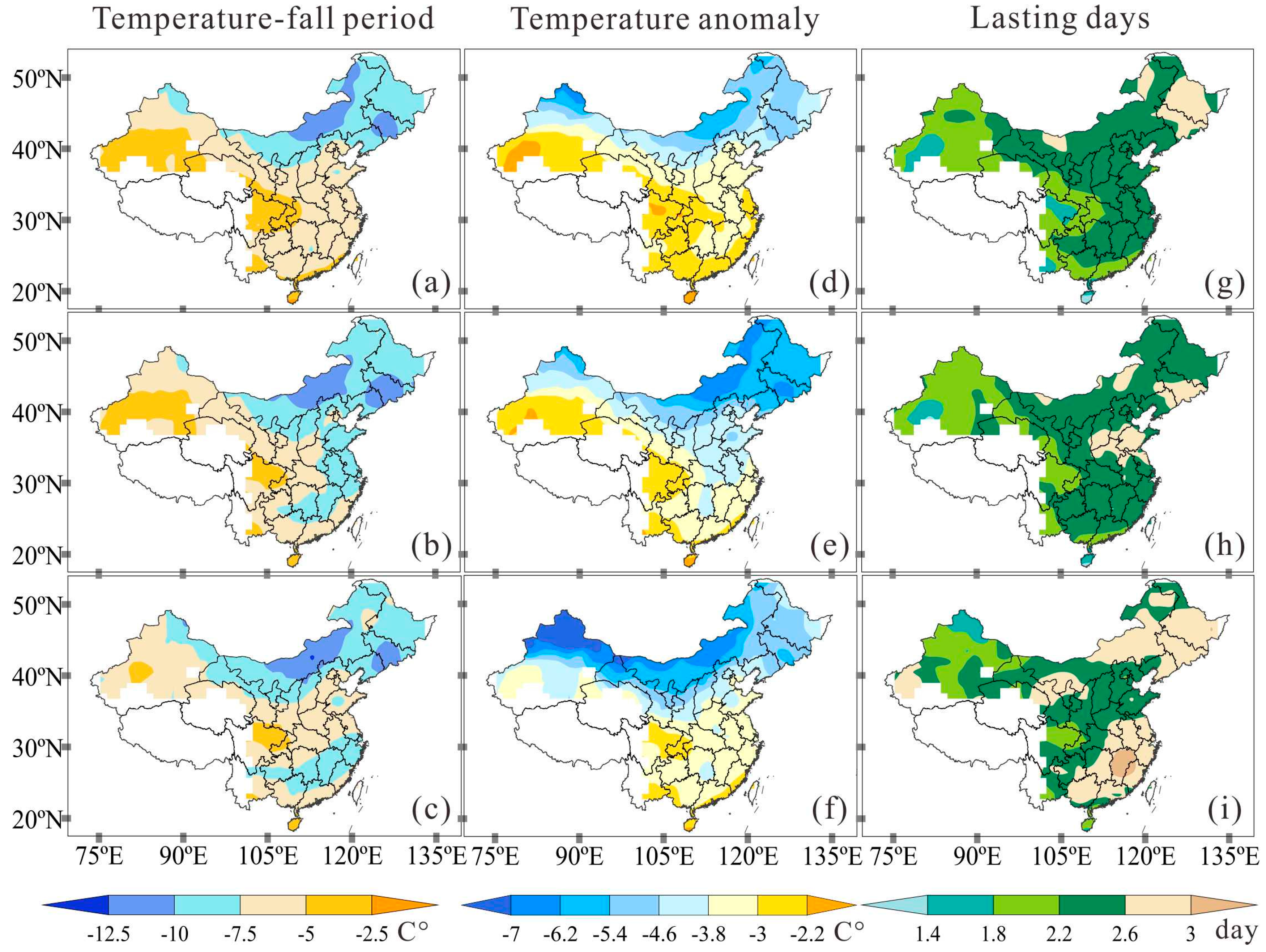
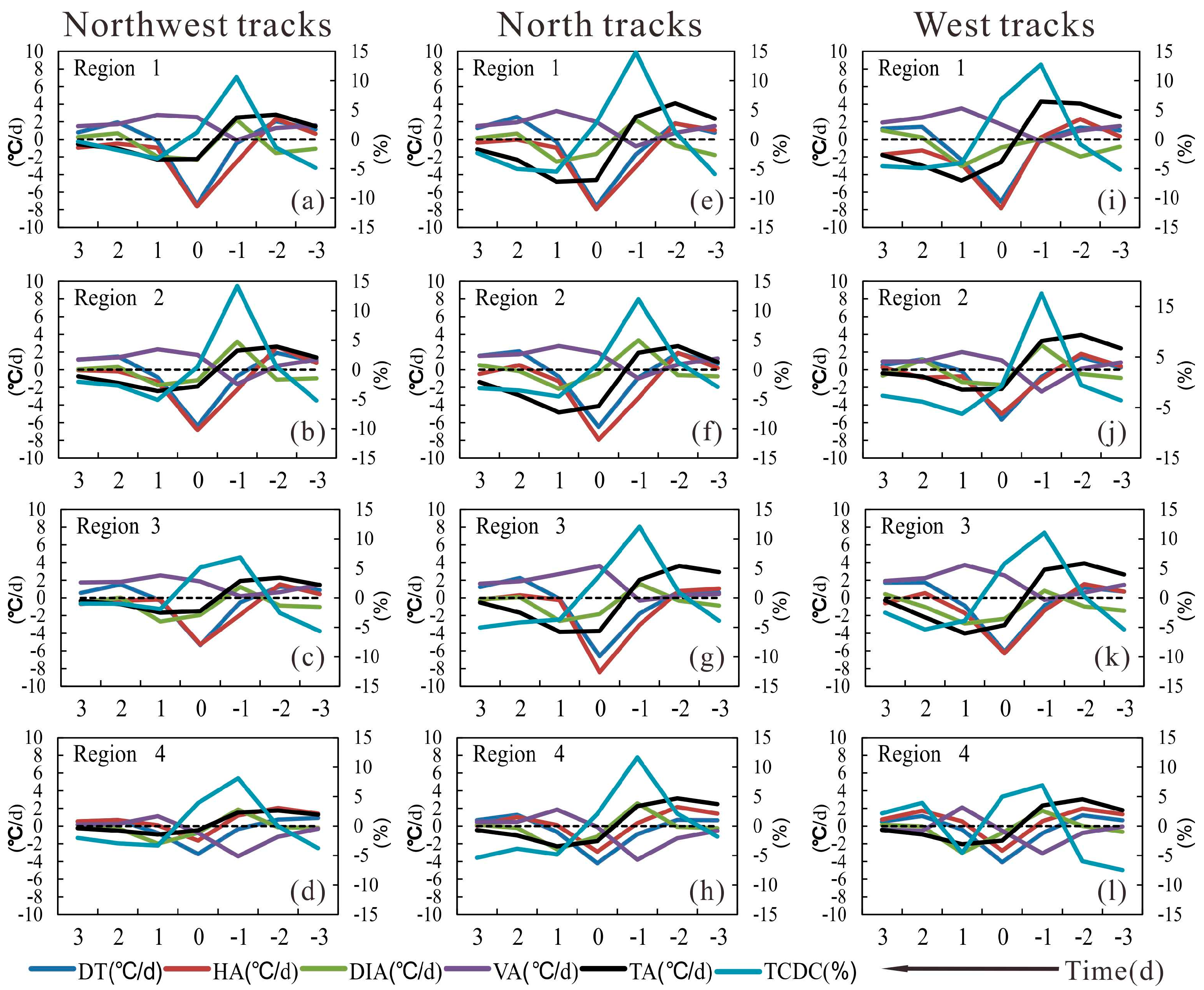
| Standard Division | Time/h | PT/°C | P/hPa | ||||||
|---|---|---|---|---|---|---|---|---|---|
| NW | N | W | NW | N | W | NW | N | W | |
| min | 32 | 51 | 64 | −68.61 | −48.23 | −55.49 | 379 | 506 | 422 |
| q1 | 91 | 116 | 121 | −27.87 | −29.41 | −31.17 | 734 | 763 | 654 |
| median | 128 | 159 | 165 | −19.55 | −23.08 | −21.34 | 832 | 838 | 748 |
| q3 | 193 | 197 | 207 | −11.48 | −16.12 | −15.63 | 900 | 897 | 839 |
| max | 296 | 258 | 324 | 7.87 | −0.09 | −1.49 | 1005 | 979 | 970 |
© 2017 by the authors. Licensee MDPI, Basel, Switzerland. This article is an open access article distributed under the terms and conditions of the Creative Commons Attribution (CC BY) license (http://creativecommons.org/licenses/by/4.0/).
Share and Cite
Wang, Z.; Sun, Z.; Zeng, G. Characteristics of Strong Cold Air Outbreaks in China’s Central and Eastern Mongolian Region between 1970 and 2013. Atmosphere 2017, 8, 98. https://doi.org/10.3390/atmos8060098
Wang Z, Sun Z, Zeng G. Characteristics of Strong Cold Air Outbreaks in China’s Central and Eastern Mongolian Region between 1970 and 2013. Atmosphere. 2017; 8(6):98. https://doi.org/10.3390/atmos8060098
Chicago/Turabian StyleWang, Zongming, Zhaobo Sun, and Gang Zeng. 2017. "Characteristics of Strong Cold Air Outbreaks in China’s Central and Eastern Mongolian Region between 1970 and 2013" Atmosphere 8, no. 6: 98. https://doi.org/10.3390/atmos8060098






